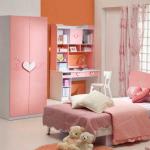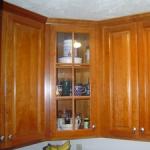The length of the kitchen cabinets. Standard sizes of kitchen furniture
By placing tall cabinets in the kitchen, you can solve several urgent problems. They visually raise the ceiling, introducing the feeling of a more spacious room. Another function is the provision of additional storage facilities. Manufacturers of furniture are guided by GOST 13025.1-85, which regulates the size of cabinets for the kitchen.
Standard sizes of floor cabinets
The reference to the height is due to the fact that the degree of convenience of performing various operations on their working surfaces depends on this indicator. A woman of average height is most comfortable cutting mix, roll during cooking, if you purchase a cabinet with a height of 850 mm. This is the minimum indicator regulated by GOST.
The range of standard heights - 850 ÷ 900 mm allows you to install higher models of cabinets in the kitchen. A change in the larger side of the distance from the floor to the upper working plane occurs due to an increase in the thickness of the countertop in the range from 28 to 40 mm. In the assortment of lower kitchen cabinets if necessary, you can find models with adjustable legs that allow you to optimally adjust their height to the particular growth of a particular person.
![]()
Features of the height of the hanging cabinets
Regarding the rational placement of the upper tier, the headset in the kitchen GOST determines the maximum height for finding the last shelf at 1.9 meters, regardless of the dimensions of the cabinets themselves. Particular attention is required to fulfill this requirement if their installation at different levels is used. The distance between the lower surface of the hinged and the upper working plane of the kitchen floor cabinet should not be less than 450 mm.
It should be noted that GOST regulates the indicated height for cases when the upper shelf is regularly used. In other situations when it is required to equip a place for storing items that are rarely used, this indicator is allowed to be exceeded.
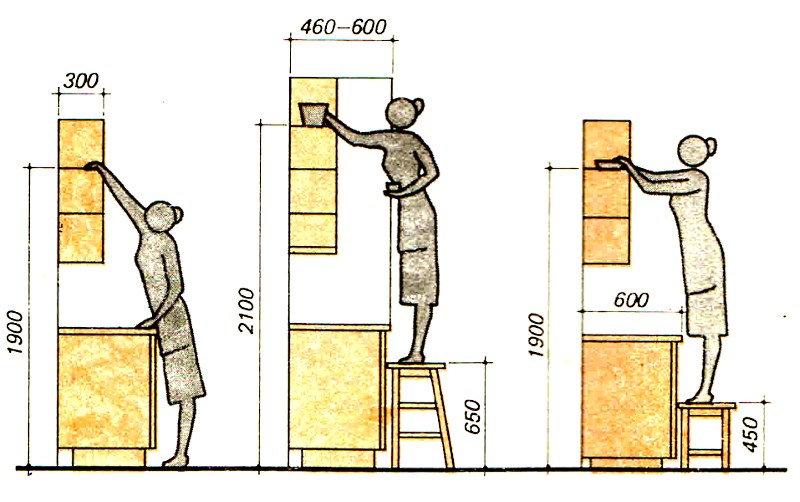
Layered Layout
Choosing the layout of the lower cabinets, you can diversify the interior of the kitchen, if you execute the upper surface not in one horizontal plane, but in several levels. In such a situation, tall cabinets, sometimes reaching the ceiling, allow the installation of household appliances in the middle sections, and the upper shelves can be used as backup storage.
Low kitchen cabinets do a good job with the role of the stand for the combine, coffee maker or decorative aquarium. In a fairly spacious kitchen, you can equip a mini flower garden and even grow greens if you put the cabinet against the wall near the window.
Custom solutions
A familiar look, standard layout kitchen room with the installation of the headset in two tiers, it is gradually transformed into a series of tall cabinets that fill the entire wall. They look especially impressive in a fairly spacious kitchen.
Among the advantages of such a non-standard solution is the presence of a large number of storage places. Also, there is no need to perform a thorough decoration of one wall, which will save time and money. A number of vertically elongated tall cabinets with a light finish visually raise the ceiling, giving the impression of a more spacious and balanced kitchen. An important criterion for the housewives is the fact that now dust will not accumulate, which was inherent in the upper surfaces of the hanging cabinets.
One of the ways to facilitate spatial perception is to arrange the top shelves open, which allows you to install collectible plates, beautiful ceramics, elegant figurines, valuable types of dishes on them. Closed kitchen facades, hiding all household appliances, create in the kitchen a feeling of a single whole image.
Article
So, standard sizes kitchen cabinets that will be placed directly on the floor should be as follows:
- The total height (from the lowest edge to the highest) is 85 cm.
- The height of the base that goes along the bottom is 10 cm.
- The thickness of the countertop can be of such sizes (depending on the manufacturer and the loads that will be assigned to it) - 2.8 cm, 3.8 cm or 4 cm.
- The depth of the countertop from the free edge to the edge adjacent to the wall is 60 cm.
- The depth of the cabinets inside them cannot be less than 46 cm. This is due to the fact that exactly 45 cm will fall on the drawer, and the remaining centimeter is necessary to create a gap between the rear walls of the drawer and the cabinet in which it is located.
- At the front, the countertop should protrude at least 3 cm, maximum 5 cm above the front of the cabinets. This is done so that no splashes and dirty stains and spots form on the facades.
- The same countertop, but only at the back, should protrude at least 5 cm, maximum 10 cm above the back of the cabinet. This gap between the cabinets and the wall is necessary in order to accommodate water and gas pipes, as well as electrical wires from the equipment.
- The width of the doors of the front facades (two in total) should not exceed 90 cm, but should not be less than 60 cm.
- The height between the shelves inside the cabinets can range from 20 to 40 cm. The height depends on what exactly will be placed and stored there.
Wall cabinets
The dimensions of the wall cabinets differ from the floor, and also include additional parameters:
- The depth of the internal space is 30 cm.
- The height of the front facades and the cabinets themselves ranges from 70 cm to 90 cm.
- The total length of all front upper facades is equal to the length of the front lower facades.
- A distance of 45 cm must be maintained between the countertop and the bottom of the upper drawers.
- Between the hood and the surface of the gas stove must be kept at least 75 cm (in the case when there is an electric stove, the distance is reduced by five centimeters).
Corner Cabinets
But the standard sizes of corner cabinets are as follows:
- The side walls of the cabinet, which run parallel to the walls, are 60 cm each. Without deduction of the subsequent cut of 13 cm long.
- The side walls of the cabinet, which are adjacent to adjacent cabinets, are 31.5 cm each.
- The front, wider section, which can subsequently be closed by a door (facade), is 38 cm.
- The back, narrower section, which enters the corner between the two walls, is 16.5 cm.

In any interior, one of the leading roles is played by correctly selected cabinets. They help to arrange the kitchen space, so you need to calculate their sizes just for your kitchen. This rule must be strictly observed in the interior of the kitchen. However, there are standard sizes for kitchen cabinets.
Types of Kitchen Cabinets
Before discussing the sizes of cabinets for a specific kitchen, their types should be listed. Kitchen cabinets perform various functions, and depending on this they are divided into the following types:
- Mounted;
- Floor standing;
- Built-in;
- Modular.
The most popular. They are equipped with hinged or sliding doors, which are also called facades. Inside, such cabinets have horizontal sections with shelves.
Kitchen furniture project
Floor cabinets sometimes act as countertops. They have drawers and shelves. The dimensions of the kitchen drawers depend on the dimensions of the cabinet itself. Wall mounted kitchen systems can be sliding or swinging. There are also corner models based on a pentagon.
Built-in or hidden cabinets save room space more than other models. They are divided into the following types:
- A cabinet for storing cutlery.
- Multifunctional closet.
- Mobile wheelchair.
- Rack for cans and bottles.
- Retractable shelving unit.
Modular kitchen systems allow you to simulate the interior of the kitchen at the discretion of the hostess. Their dimensions do not depend on the space of the kitchen or existing furniture. as necessary can be supplemented with new elements.
But no matter what type of cabinets you choose, it is worthwhile to dwell in more detail on which cabinets will be appropriate in this kitchen, standard or custom-made, in accordance with pre-made measurements. Sizing of kitchen cabinets complicates the presence of other elements of the headset. Their sizes should correspond to each other.
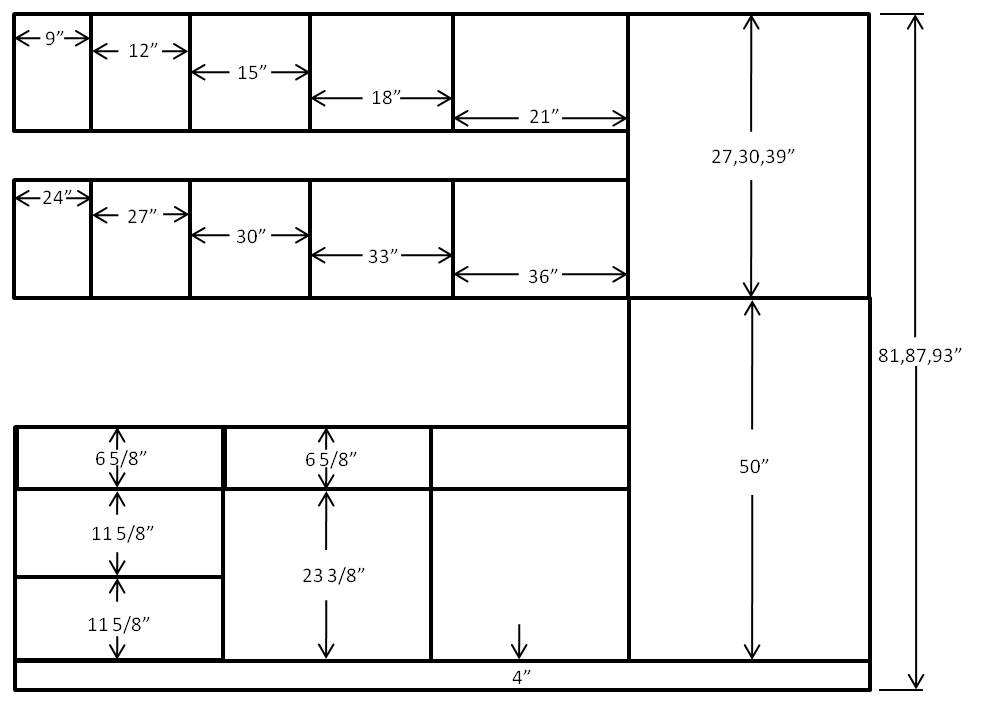
Dimensions of standard kitchen cabinets
Standards for the size of kitchen furniture
In order to simplify the calculations, certain standards have been developed. Standard height cabinets in most cases is 82 cm. The standard thickness of the countertops is 2.8 cm and the width is 60 cm. Therefore, the total size will be 85 cm, and this size is usually the width of washing machines. It is designed for them. The width of the cabinets is usually 45 cm, and the standard depth of the cabinets is 30 cm.
The standard width of the cabinets is 30-50 cm for single-leaf, and 60-100 cm - for double-leaf. The best width for corner cabinets will be 90 cm. The standard depth of the lower cabinets is 50-55 cm.
Self-assembly kitchen
If standard furniture does not fit, you can order it from a company that will do everything according to individual size. The size kitchens ordered from the manufacturer usually cost more and are completed within a few weeks.
Depending on the type of installation, kitchens are divided into those that have standard dimensions and those that are designed for specific sizes. Standard dimensions have been described above. If furniture with them for some reason does not fit, then order a kitchen by individual standards. Measurements are usually made by a specialist of the manufacturing company.
The order of the kitchen in size is necessary if the dimensions of the room are non-standard, or if there is already some kind of furniture, for which you need to choose cabinets.

Custom Design Furniture
A set of kitchen furniture of non-standard sizes can be selected from furniture of standard sizes, simply by combining several cabinets or cabinets. In addition, when choosing a kitchen individually, it should be remembered that kitchens are straight and angular. The former are installed under one wall, and the latter can have several corners or corner sections.
A do-it-yourself kitchen cannot be completed without the necessary set of tools. To build, you will need the following tools:
- Screwdriver;
- Cross and hexagonal bits;
- Hammer;
- Level;
- Roulette;
- Jigsaw.
The assembly includes the following stages of work:

With the independent selection of furniture, many are wondering how to calculate the size of the facade of the kitchen. Different manufacturers of facades have their own standard dimensions. But if you need to perform an independent calculation, then you need to consider the indents from the edges of the modules, usually they are equal to a couple of millimeters. It is these indents or gaps that determine the dimensions of the facades.
We consider that the kitchen module has a given height h and width l. Then, setting the indent for both sides at 1.5 mm, we get an indent of 3 mm. So, in order to get the dimensions of the facade, it is necessary to subtract 3 mm from h and l. The result obtained will be the desired one.
Small kitchen furniture
In order to create a cozy design of a small kitchen, you need to choose the right furniture. It is not easy to furnish a small kitchen and still leave space.
The angular view of the layout allows you to place compact equipment and allocate space for the working area. Furniture is placed along two combined walls. This visually expands the space.
It is not only possible to select a kitchen by size, but also necessary. Experts definitely do not recommend purchasing a ready-made headset, but recommend ordering an individual design. An additional plus is that it is possible to independently choose the material, color and accessories.
We all know what the size of the kitchen in the apartment should be. But if it is far from ideal, then you can increase the kitchen space due to the play of color and light. The color scheme for small-sized kitchens is selected in bright colors. Although it will not be superfluous to create contrast by adding bright details. This is necessary in order to visually expand the space. The original solution can be found in a combination of black and white. A bright detail may be an element of decor in juicy green, yellow or red.
As for furniture, it is not necessary to design a kitchen with heavy furniture made of natural wood. This will look overly bulky and reduce the already small space.
The total volume of a small kitchen can also be increased due to the brilliant mirror details, for example, chrome fittings. With the right lighting, you can create a feeling of weightlessness in the kitchen.
The owners of a small kitchen, such as, for example, must follow several rules in order to optimize the space in it:
- Prefer angular type of layout and cabinets with swivel or roll-out system. Such models are easy to hide under the sink. At the corners you can arrange the shelves-carousels for kitchen utensils.
- Select furniture with less depth. The usual depth of the cabinets according to the standards is 60 cm, and for a small kitchen, a depth of 40 cm is suitable.
- Use in planning large hanging cabinets. This will visually increase the height of the ceiling of the room.
- You can find use for the empty space under the window.
- Doors with a sliding system will be in a small kitchen.
- For the dining area is suitable transformer table.
- Choose the smooth facades of cabinets with glass or mirrored doors.
- Choose the right lighting and the right colors for your kitchen.
Now you know the standard sizes of cabinets for the kitchen of any size, as well as methods of calculation and self-assembly of kitchen furniture.
To create a comfortable environment, it is not enough to choose the kitchen set itself, it is important to make sure that it fits stylistically to the decor and is harmoniously located in the kitchen. What problems can arise in the design planning process?
Difficulties can create:
- low or, conversely, very high ceilings;
- features of planning standards;
- the location and size of the mandatory kitchen components - counters, geysers, etc .;
- place of summing up communications.
Standard kitchen
In the manufacture of kitchen sets of a standard type, the dimensions of typical apartments and the parameters of the average person are taken into account. When choosing kitchen sets in the store or on the website of the manufacturer, you need to know the height of the ceilings in the kitchen and the dimensions of the free wall on which the installation of cabinets is supposed. The photo shows the standard sizes of the kitchen set.

Any kitchen set can be divided into components:
- hanging cabinets,
- floor lockers
- countertop.
Hinged cabinets are lighter than the floor and have a shallower depth - usually 300 mm. They are designed for light cooking utensils and utensils. Often, the standard in the upper module is assumed to be a built-in hood, as well as a place for installing a microwave oven. In addition, the standard is the location of the built-in lighting fixtures in the bottom panel of the mounted modules. For a harmonious perception of the kitchen set, the width of the upper drawers (cabinets) should be equal to the width of the lower ones.

Standard sizes of kitchen unit floor modules:
- height of lockers - 820-850 mm;
- countertop thickness - 30-40 mm;
- the depth of the lower modules is 600 mm.
As a rule, all surfaces of the kitchen set are located at the level of the working surface of the countertop, and the standard distance between the upper and lower cabinets is maintained at 450-600 mm.
Standards have been developed to make the use of kitchen furniture as comfortable as possible and not burdensome for the back. In addition, the mentally created triangle “stove-refrigerator-sink” should ideally be equilateral. The completed drawing example represents the dimensions of a Standard kitchen unit.

Among the existing standards of kitchen furniture, there are more and more options when the surfaces are located at different heights. This is due to the desire to alleviate the strain on the back while working in the kitchen.
Corner Kitchen Sets
To save space in a small kitchen will help the installation of a corner kitchen set, which can be presented in two versions:
- standard - made taking into account the size of a typical apartment, but not taking into account some of the nuances of decoration and design;
- non-standard - as a rule, it is custom-made and takes into account not only the dimensions, but also the individual characteristics of the room, such as multi-level ceilings, bay windows and more.

The advantages of a corner kitchen set:
- Save space.
- The corner kitchen set is ergonomic, with its help it is easiest to implement the “stove-sink-refrigerator” scheme.
- It is easier to distinguish the dining and working areas.
- Functionality - involuntarily small sizes force the most efficient use of cabinets and surfaces.
- Small space optimization.
In addition, corner furniture can be created on an individual order, the drawing of which will take into account all the features of the room and the wishes of the customer. In the photo you can see the diagrams and sizes of the corner kitchen set.
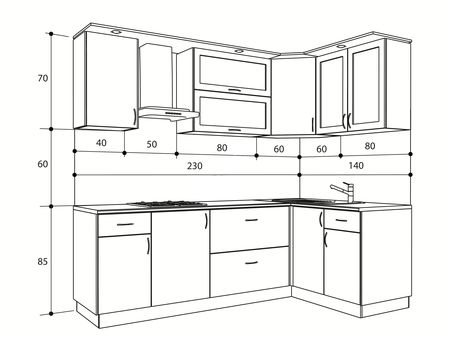
Kitchens to order
In addition to acquiring standard options for kitchen furniture, there is always the opportunity to order a set according to your own drawing. Even if you do not have designer talent, drawing up a kitchen diagram is not difficult. But already to clarify the individual details and sizes will require the help of a specialist.

You can see on the photo drawings of kitchen sets with dimensions. Having ordered the manufacture of a kitchen set, you can be sure that you will receive a kitchen set according to the size of the kitchen, and in addition:
- The exact dimensions of your kitchen will be taken into account.
- The drawing will prescribe those standards for the distances between the headset modules, which cannot be changed.
- Using a graphical editor will allow you to see not only the diagram, but also the finished photo of the future kitchen.

Whatever option of a kitchen set you choose, it is important to remember, first of all, that the kitchen must be not only functional, but also safe. This means that, when creating drawings and diagrams, you need to take into account the location of the communications, the location of electrical outlets, lighting devices and switches.
A well-designed kitchen drawing is the guarantor of an efficient and trouble-free furniture assembly. A detailed design of a kitchen unit with dimensions will help to avoid common mistakes during installation. The article contains practical advice from professional furniture makers, answers to frequently asked questions by beginners, ready-made drawings of standard and corner kitchens, as well as competently calculated details of the main types of cabinets.
The dimensions of the kitchen set are dictated by the dimensions of the premises, the nuances of the location of communications, doorways, windows, niches and ledges. Therefore, it is extremely important to make accurate measurements, indicating all the elements on the plan.
Measurements on the form:



When developing a kitchen project, the dimensions of household appliances, the standards of countertops, the acceptable dimensions of cabinets (height, width, depth) should be taken into account.
- Information on the dimensions of the equipment is in the technical passport prepared by the manufacturer.
- Standard sizes of worktops made of chipboard:
- height: 28 and 38 mm;
- length: 3050 and 4200 mm;
- depth: 600, 800,1200 mm.
Standard sizes of kitchen cabinets
The height of the upper tier varies between 70-90 cm in increments of 5 cm.
The height of the lower tier of the kitchen: 850 or 900 mm. Depth of the lower cabinets: 500 mm - in this case, the overhang of the countertop will be 4 cm in front (above the facades) and 6 cm in the back.
Depth of wall cabinets - 30 cm excluding doors.
Standard width of kitchen cabinets: 300, 400, 500, 600, 800, 1000 mm. Standard for Cargo Mesh (Bottles): 150, 200, 300 mm. The width of the cabinet under the hood: 600, 700, 900 mm.
Overall dimensions of the lower corner cabinet: 800x800 or 900x900 mm.
Upper corner cabinet: 550x550 or 600x600 mm.

Location of standard cabinets in a direct kitchen

Drawing of a standard set of furniture for a direct kitchen

Location of standard cabinets in the corner kitchen

Standard drawing corner kitchen with horizontal drawers
Design Principles for Custom Cabinets
If it is impossible to use the standard sizes of kitchen cabinets, you must independently create a drawing of each cabinet separately, taking into account the nuances of the room. Some options when you need custom furniture:
- Protrusions or niches in the wall. In this case, the depth of the cabinet varies depending on the size of the wall deformation. That is, if there is a 200 mm niche behind the proposed furniture, it is quite possible to increase the depth of the cabinet by 150-180 mm. If, on the contrary, a ledge is located behind the back wall of the furniture, then the depth should be made less.
- The presence of communications, outlets. Here you need to make sure that there is free access to important communication nodes (joints, connections, ventilation grilles, valves, taps, etc.) and to free use of the outlet for its intended purpose. To do this, first, a schematic image of the objects is placed on the kitchen drawing, and during the design of each cabinet, they are drawn with a dashed line on the back wall. The dash line is an option for specifying places for cutouts during assembly and installation.
- An individual idea, complex furniture configurations, etc. In this embodiment, each furniture element is developed individually by a separate drawing. It is advisable to draw all the complex joints in close-up.

The ledge in the wall: an approximate drawing of the lower kitchen cabinet

Drawing of a hinged box with a recessed rear wall under the gas pipe
Examples of kitchen units with dimensions
The construction and design of the kitchen is always based on the overall dimensions of the room. After all strategic objects (pipes, sockets, ledges, etc.) are already placed on the drawing, you can proceed with the arrangement of cabinets for household appliances. Next, you should place standard furniture, and only then - non-standard designs.
Ready-made direct kitchen projects
When developing your own kitchen drawing, you can rely on ready-made kitchen projects with dimensions, while correlating the actual dimensions of the room with those indicated in the sketch.
Standard kitchen unit with dimensions:


Drawing of a direct kitchen with non-standard cabinets:


Variants of drawings of corner headsets
Standard corner kitchen with dimensions:

Standard corner kitchen with dimensions
Designing a kitchen with a trapezoidal corner element:

Custom corner kitchen drawings:

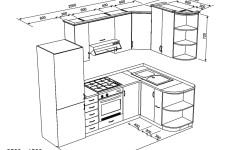

Detailing of main kitchen cabinets: drawings and dimensions
- Calculation of detailing is made taking into account the thickness of the chipboard.
- The standard thickness of the chipboard for the manufacture of kitchen furniture is 16 and 18 mm.
- Lower kitchen drawers mounted on adjustable feet 10 cm high.
- The supporting strip (lower base) is recommended to be made integral - inextricable for the entire kitchen.
- The following details and drawings of the kitchen are designed for chipboard 16 and countertop 28 mm.
- The height of the lower tier is 850 mm, taking into account the countertops, the upper - 720 mm.
Built-in oven cabinet

Washbasin cabinet
The width of the cabinet varies with the length of the sink.

Drawing of a kitchen cabinet for a sink of 800 mm
Drawer cabinet
The width varies according to the size of the premises or the wishes of the customer.

Sketch of a cupboard with 4 drawers, size 400x500
Lower pedestal with swinging facades
The size can vary in width within 300 ... 1000 mm.

Drawing of a kitchen cabinet with two doors, width 600
Corner cabinet: two options

Sketch of the L-shaped corner section 900x900

Drawing of the lower corner pedestal in the shape of a trapezoid 900x900
Telescopic hood cabinet
The width of the cabinet varies depending on the width of the hood, the height is calculated relative to the sizes recommended by the manufacturer of household appliances.

The project of a hinged kitchen cabinet under a standard telescopic hood 600 mm
Wall cabinet with swinging facades

Drawing of the upper box with swinging facades 800x720
Wall-mounted corner cabinet: two options

Drawing of an angular L-shaped cabinet 600х600

Sketch of a trapezoidal corner upper cabinet 600x600
FAQ: Answers to Common Newbie Questions
- How to make measurements of the kitchen yourself?
It is necessary to measure the room at different heights: at floor level; in the area of \u200b\u200bthe working surface (850 ... 900 mm from the floor); at the level of human growth. This is necessary to identify wall irregularities. Height is also better to measure at several points - to detect the curvature of the floor, ceiling.
Important! Horizontal measurements to objects in the kitchen (counters, pipes, windows, etc.) must be done from one angle taken as the base.
- What computer programs are suitable for a beginner to independently develop a kitchen drawing?
The simplest design program is the PRO100. Intuitive and easy to understand: Astra Furniture Designer, bCad-furniture maker, KitchenDraw, WOODY, IKEA kitchen planner (great for standard furniture sets), AutoCad, 3D-constructor, Basis.
- Why do drawings of kitchen sets with dimensions always contain a gap in the area of \u200b\u200bthe walls?
In the design of kitchens, especially corner ones, it is very difficult to predict how perfectly the furniture will fit into the given dimensions of the room. No one is immune from the mistakes of builders who left uneven walls after their work. A small gap of 5-7 cm helps furniture makers install the headset without major alterations - if the sizes do not match, the furniture can be moved within these limits, and at the end of the work, cover the remaining gap with the part in the color of the facade.
- What distance should there be between household appliances in the kitchen?
It is best to leave at least 500 ... 600 mm between the equipment.
- Can I install a washing machine in the kitchen?
Yes of course. The main rule: the distance from the washing machine to the nearest kitchen cabinets should not be less than 3 cm on each side.
- How many centimeters should be between the lower and upper tiers of kitchen furniture?
The optimal distance is 60 cm. The exception is the hood for the hood - here you need to rely on the recommendations spelled out in the technical passport of the device.
- In what order is it better to place household appliances on the kitchen drawing?
For right-handed people, the most acceptable option is a refrigerator, a sink, a stove. In this case, the hostess moves from left to right: removes food from the refrigerator, peels and washes them, then cuts it (between the sink and stove), and then cooks, fries, stews. For left-handed people, it is better to use the mirror version of the arrangement of household appliances: stove, sink, refrigerator.
- Why is it considered that the furniture on the legs is more durable than the one with the side parts of the cabinet lowered directly to the floor?
Kitchen cabinets with adjustable legs can always be set to a level relative to the floor. In addition, in the event of various types of emergency (the neighbors flooded from above, the crane broke, etc.), only the lower base deteriorates, the replacement of which is less expensive than updating the side parts of the cabinet.
- What should the back wall of kitchen cabinets be made of?
It is better to use fiberboard - it does not negatively affect the reliability of the structure, and at a price it is more attractive.
- In what units of measure do you need to indicate the dimensions of the kitchen sets in the drawings?
Only in millimeters.
- Where should the sockets be located?
The layout of the sockets relative to household appliances:


- Is it possible to install a worktop 40-50 cm deep in one of the walls in a corner kitchen?
No problem. The only condition is that in this part of the kitchen set there should be no built-in household appliances and sinks. All kitchen appliances have standard sizes, designed for a table top of 60 centimeters.
- Standard kitchen drawings with sizes better or worse than design?
There is no definite answer. For a typical kitchen, you can use the standard set of furniture, but for rooms with redevelopment, an individual calculation of the kitchen set is really necessary.
Creating a drawing is not an easy and time-consuming process. But phased planning, clear measurements, proper placement of furniture and appliances, as well as strict adherence to instructions and advice of professionals will certainly succeed. A linear sketch of a direct location or a 3-D drawing of a corner kitchen with dimensions and detailing is the first step towards kitchen set of your dreams.





